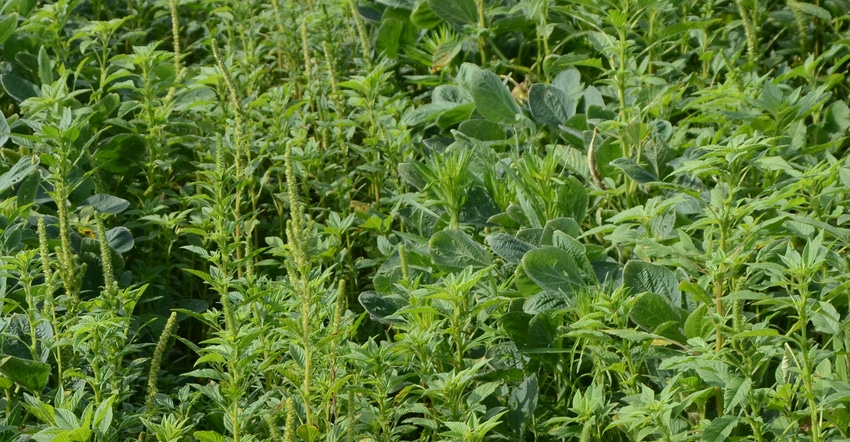
For most growers, the days before Roundup Ready crops are a distant memory — younger growers may not even remember using bean buggies or field cultivation for weed control. But as Bob Hartzler, Iowa State University emeritus professor and Extension weed specialist pointed out in a recent Iowa Learning Farms webinar, a lot has changed in weed management in Iowa in the last 40 years.
"I arrived in Iowa in 1982. At that time, over 95% of the corn and soybean acres were being treated with herbicide," Hartzler said. "We reached saturation of herbicides on the acres sometime in the mid-’70s. Herbicides had become the dominant form of weed management by the start of the 1980s."
Herbicides through the years
Since then, herbicide use has stayed relatively consistent, but the kinds of herbicides used have changed. This has also resulted in a significant reduction in tillage.
Group 4 herbicides, like 2,4-D, dicamba (or in the case of soybeans, chloramben), were used in postemergence applications on about 25% of corn acres and 10% of soybean acres in 1985, according to USDA National Agricultural Statistics Service data. As of 2018, the use of Group 4 herbicides had risen to about 45% in corn acres, and had stayed the same for soybean acres.
Group 5 herbicides, or triazines, were used on about 60% of corn acres and 55% of soybean acres in 1985. As of 2018, use of Group 5 herbicides had remained relatively consistent in corn on about 55% of acres, and had dropped to 20% of soybean acres.
In soybeans, Group 3 herbicides like trifluralin (Treflan) and pendimethalin (Prowl), were used on about 70% of acres in 1985. Both of these herbicides required mechanical incorporation. As of 2018, Group 3 herbicides have dropped to less than 20% of soybean acres, allowing a reduction in tillage. These herbicides were largely replaced by Group 15 herbicides (rising from 20% of soybean acres in 1985 to 80% in 2018) for grass control.
Unsurprisingly, one of the groups to see the biggest change in use is Group 9, which includes glyphosate. Group 9 became dominant with the introduction of glyphosate-tolerant crops in the 1990s. According to USDA data, Group 9 herbicides were used on 65% of corn acres and more than 80% of soybean acres in 2018, rising from less than 10% in 1985.
Group 9 herbicides largely replaced Group 2 herbicides, or ALS inhibitors, which weren't introduced until the late 1980s. These herbicides were used on 50% to 60% of corn and soybean acres in the early 1990s, but have since dropped to around 20%.
In addition, Group 27 herbicides, or HPPD inhibitors, which were introduced in the late 1980s, saw a significant increase in use, and were used on about 70% of corn acres in 2018.
"Herbicide use has remained consistent over the last 40 years. There have just been changes in products used," Hartzler said. "We're relying on a fairly limited number of products to control weeds. That has led to a selection of weeds that are adapted to herbicide."
Old weeds, new problems
There's also been a change in "problem weeds." Hartzler ranked the top problem weeds in the Corn Belt in 1982 and 2016, based on the number of citations in the North Central Weed Science Society's annual meeting proceedings. In the early 1980s, foxtail was the most-studied weed, followed by velvetleaf and redroot pigweed, with cocklebur and lambsquarters tying for last. In 2016, the No. 1 problem weed was waterhemp. Giant ragweed and marestail tied for second, followed by foxtail and lambsquarters. Interestingly, Hartzler noted the top three problem weeds in 2016 are native species.
"Those three native species represented 0.6% of the citations [in 1982]. But in 2016, they're greater than 60%," Hartzler said. "I find it intriguing that native species that have always been here, which were not viewed as big, agronomic weed problems, are now the dominant weeds."
Hartzler noted the first weed to show herbicide resistance in Iowa was kochia, which was resistant to Group 5 herbicides in 1985. Then came lambsquarters, which was confirmed resistant to Group 5 in the late 1980s. Both of the cases were confined to a relatively small number of acres. Bigger problems arose in the mid-1990s, when waterhemp was found to be resistant to Group 2 herbicides.
"At that time, probably 80% to 90% of soybean acres were being treated with a Group 2 herbicide. That resistance just spread across the state within a three- or four-year period," Hartzler said. "And waterhemp hasn't stopped evolving resistance to other herbicides since then."
Waterhemp developed resistance to Group 5 herbicides in the late 1990s, followed by Group 9, Group 14 and Group 27 in the 2000s. Meanwhile, giant ragweed and marestail have since developed resistance to Group 2 and Group 9 herbicides.
"Waterhemp is the best example of the consequences of this high level of reliance on herbicide that's going to change how we manage weeds," Hartzler said.
Whether this will mean a change in management strategies to include practices like cover crops or controlling weed seed at harvest, Hartzler noted that in the coming years, weed management will need to change from relying solely on herbicides.
"I just don't see how we can continue as we have the past 30 years, relying almost entirely on herbicides," he said. "I would hate to see us go back to using intensive tillage like we used to do."
About the Author(s)
You May Also Like






